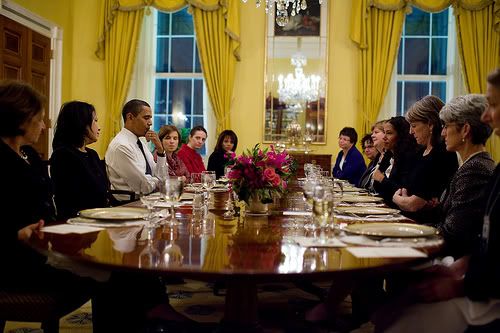
By now most of you have probably heard about the controversy stirred up about women in the White House coming from Ron Suskind's latest book Confidence Men. From what I've read, it sounds like there was a problem in the beginning. But when folks want to suggest that this indicates the President has a problem with strong women, I have to say "puhleeze...have you taken a look at who he's married to?" For a long time now I've suggested that the best way to evaluate a man's embrace of feminism is to look at who he chooses to commit himself to in a long-term relationship. Barack Obama passes that one with flying colors.
Now that we've gotten that one out of the way, it's significant to look at how Suskind misquoted former staffer Anita Dunn. Here's how Suskind wrote the quote in his book:
Looking back, this place would be in court for a hostile workplace....Because it actually fit all of the classic legal requirements for a genuinely hostile workplace for women.
But a recording of Suskind's conversation with Dunn shows that this is what she actually said:
I remember once I told Valerie [Jarrett] that, I said if it weren’t for the president, this place would be in court for a hostile workplace....Because it actually fit all of the classic legal requirements for a genuinely hostile workplace to women.
Those six words Suskind decided to leave out change the whole trajectory of the story.
According to this article by Peter Wallston and Anne Kornblut, there were tensions about this in the beginning of this administration.
In interviews at the time, female officials complained that top aides fueled the high-testosterone atmosphere. Footballs were occasionally thrown during staff meetings, by one account. Rough language abounded...
According to another official, the president initially discounted the complaints he heard that women, particularly on his economic team, were making. He saw the tough climate as just that — the intense atmosphere of a White House, fostered by competitive people at the top of their game.
It seems that much of this was fueled by the disagreements between Christina Romer and Larry Summers. And of course, we're all shocked that Summers can be an asshole, right? LOL
But here's what Romer said about her experience.
“I was told before I went to Washington that there has always been a lot of testosterone in the West Wing,” Romer said Friday. “What was different in the Obama administration is that there were so many women in important positions and, when problems arose, the president worked hard to fix them. I felt respected, included and useful to the team.”
What President Obama did, at the suggestion of Valerie Jarrett (gotta love that woman!), is to have a dinner with the women who worked in the White House on November 5, 2009 (picture above).
“I really want you guys to talk to me about this openly because recently there has been this suggestion that there are some issues here,” Obama said, according to Suskind’s account of the session. “I’d like to know how you guys feel.”
And the result:
The complaints seemed to subside over the last year, as officials have made a greater effort to promote women and the tight-knit inner circle has shifted to bring new advisers into the building.
Rather than being a critique of the President, I think this kind of process should be held up as an example of how to resolve the ubiquitous effects of patriarchy in the workplace. First of all, the women were strong enough to speak up about what they were experiencing. Secondly, they were heard. And finally changes were made. In too many workplaces change gets bogged down in one of those three steps. President Obama and his team demonstrated how to make it work!




Looks like Suskind tried to create his own reality.
ReplyDeleteHe was more at home with the Bushies than he'd like to admit. That's just plain dishonest.
Dr. Squid - I watched Suskind for a bit last night on MSNBC. When talking about the dinner I referenced above, he referred to it as if the women demanded the meeting and confronted PBO. Its fascinating what a little twist of language does to the story. But he seems to have dug himself into a narrative and needs to find a way to defend it...a pretty common phenomenon these days.
ReplyDeleteThese days? My intro to the blogosphere was the Daily Howler back in 2000, and narrative-building was surely going on then, and way before that.
ReplyDeleteDoesn't make it any less pathetic, though. It's like the Young-earth creationist approach to data: Draw curve, plot points later.